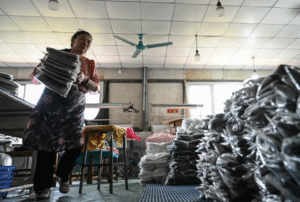China’s exports to the U.S. dropped significantly in April, while its trade with other nations surged, highlighting how President Trump’s tariffs are reshaping global supply chains. Overall, China’s exports grew by 8.1% year-on-year, exceeding expectations of a 2% increase. However, this was a slowdown compared to March’s 12.4% rise. Imports into China also declined slightly by 0.2%.
Shipments to the U.S. plummeted by 21% in dollar terms, as Trump’s tariffs on most Chinese goods reached as high as 145%. Meanwhile, China imposed retaliatory tariffs of 125% on U.S. goods, creating an increasingly uncertain business environment between the world’s two largest economies. China’s imports from the U.S. also fell by over 13%, and its trade surplus with the U.S. narrowed to $20.5 billion in April, down from $27.2 billion a year earlier.
For the first four months of the year, China’s exports to the U.S. were down 2.5%, while imports from the U.S. fell by 4.7%. Negotiations to resolve the tariff conflict could take place soon, with senior trade officials from both countries meeting in Geneva. However, significant differences in their strategic interests may hinder progress. While some tariffs may be reduced, a complete rollback seems unlikely. As a result, China’s exports to the U.S. are expected to continue declining, with export growth likely turning negative later this year.
Despite this, China’s exports to other markets are thriving, reflecting a shift that started years ago and has accelerated as a result of Trump’s tariffs. Global manufacturers are increasingly seeking alternatives to relying solely on Chinese production after the disruptions caused by the COVID-19 pandemic, which highlighted the need for more diversified supply chains.
Exports to the U.S. made up about 10% of China’s total exports in April, with the U.S. still being the largest single-country market for China. However, trade with regions like the European Union and Southeast Asia is more significant, as well as trade within the 15-nation Regional Comprehensive Economic Partnership (RCEP), which excludes the U.S. Exports to countries involved in China’s “Belt and Road Initiative” are also larger than those to the U.S.
In the first four months of 2023, China’s exports to Southeast Asia and Latin America each grew by 11.5%, while exports to India surged by nearly 16%, and trade with Africa grew by 15%. Particularly strong growth was seen in Asia, with exports to Vietnam rising by 18% and to Thailand by 20%, as manufacturers look to diversify supply chains outside China.
In response to the trade war’s impact on its economy, China has announced a series of measures to mitigate the effects, as trade activity and shipping data show a sharp decline. These challenges come on top of China’s ongoing economic struggles, which include recovering from the pandemic and a prolonged downturn in its housing sector.














